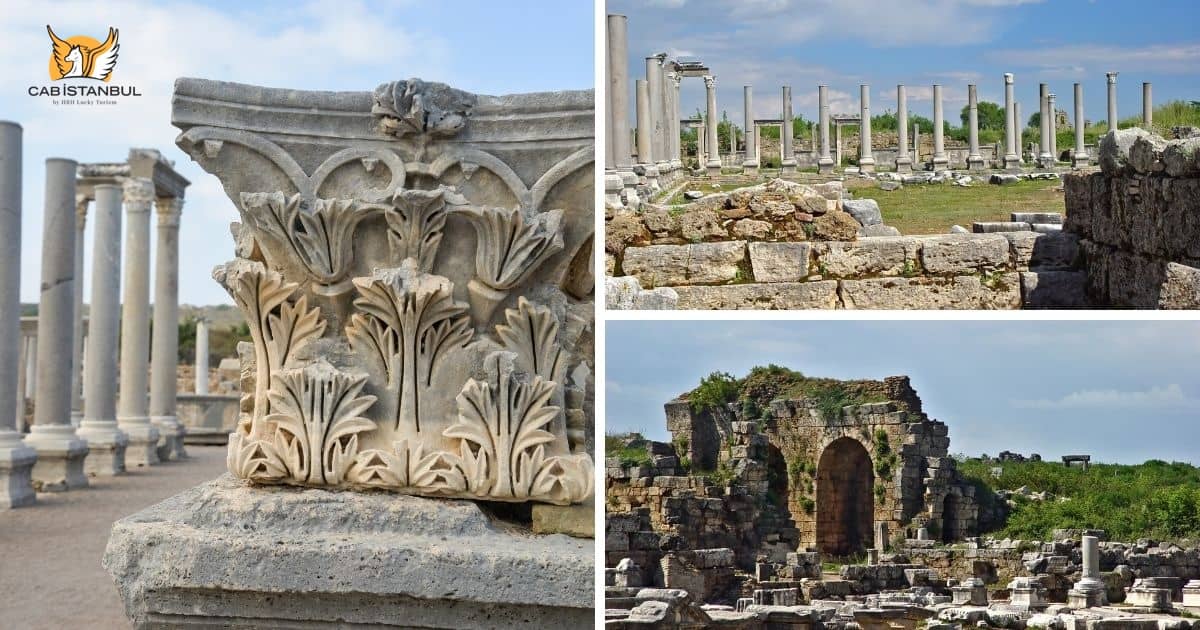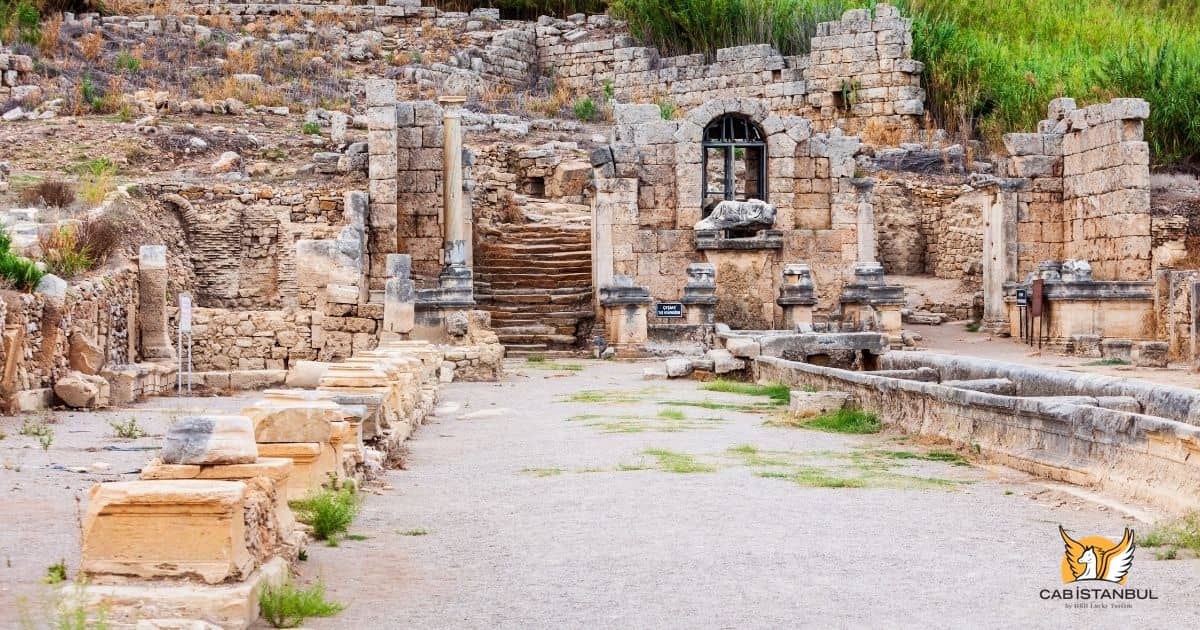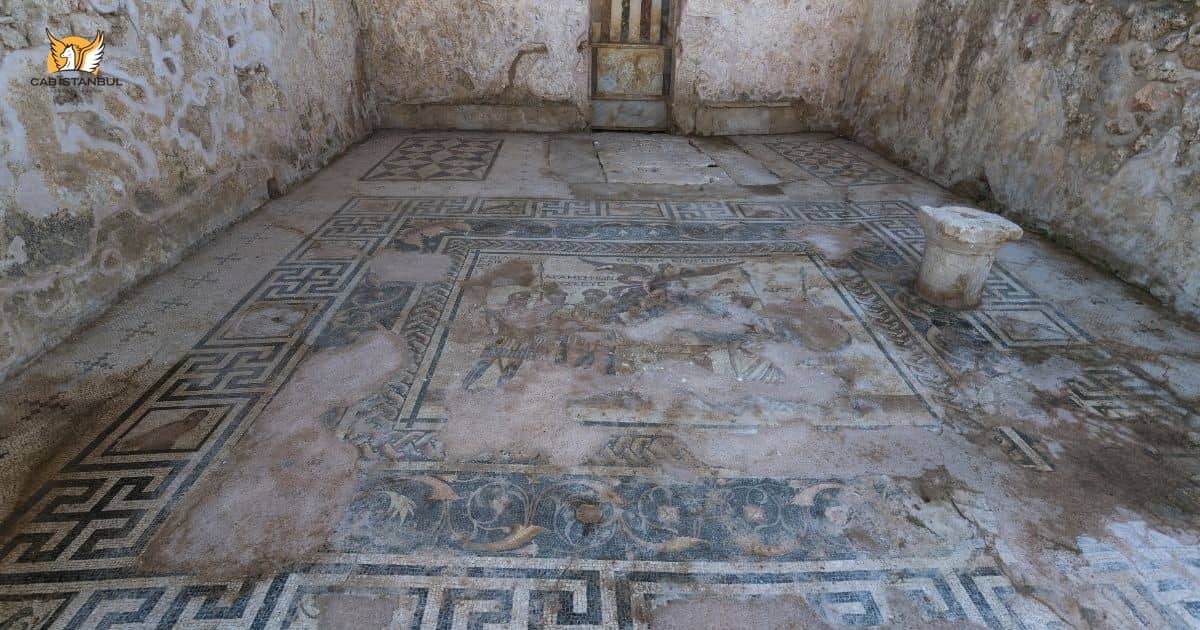Perge Ancient City
2026-01-08

Perge Ruins Antalya
Perge Ancient City, a treasure trove of history nestled near the vibrant city of Antalya/Turkey. As one of Turkey's most significant archaeological sites Perge, echoes of Alexander the Great and the Apostle Paul still resonate through its storied ruins. We will take you on an exploratory adventure through Perge's stunning Hellenistic and Roman ruins, highlighting its remarkable features such as the imposing Stadium, majestic Hellenistic Gates, serene Roman Baths, bustling Agora, and more. Uncover the secrets of the third-largest theater in Turkey, marvel at the well-preserved Roman Stadium—the best of its kind in Western Turkey—and wander through the remains of the extensive Roman Bath complex. Hellenistic Gates that once welcomed kings and scholars, and stroll the Agora where traders and citizens mingled amidst the beauty of ancient civilization.
Delve into the marvels of Perge Ancient City, free from the concerns of private transfer arrangements. Cab Istanbul car and driver service ensures a seamless experience, prioritizing your comfort and serenity. With us by your side, you can truly immerse yourself in the captivating history and allure of this esteemed archaeological treasure.We've got you covered with all the essential information on admission fees, visiting hours, and travel tips to ensure a seamless experience. Whether you're a history enthusiast, an avid explorer, or simply in awe of the past, Ancient Perge promises an unforgettable adventure into the heart of ancient history.
Perge Ruins
Perge Archaeological Site
The Ancient City of Perge is a signature archaeological site in Pamphylia, founded around 1000 BC near the Aksu River. Flourishing under Roman and later Byzantine rule, Perge became a cultural hub and the birthplace of Apollonius of Perga. Visitors today can trace a classic urban plan: a long colonnaded street leading to a grand agora, well-preserved Roman baths, monumental city gates, and a commanding acropolis. These remains reveal Perge’s prosperity from trade, agriculture, and strategic location on key routes across southern Anatolia. Although the city declined as routes shifted and disasters struck, excavations now uncover everyday life, public architecture, and sacred spaces spanning Hellenistic, Roman, and Byzantine eras. Exploring Perge means walking through layered history—an immersive encounter with the engineering, artistry, and civic spirit that once defined this enduring Ancient City.
Ancient City of Perge
Ancient City of Perge, a remarkable beacon of history situated in Turkey's panoramic landscapes. This archaeological marvel offers a window into the Hellenistic and Roman eras, where architecture and artistry converge to narrate tales of antiquity. From the footprints of Alexander the Great to the sermons of Apostle Paul, Perge's stones and ruins whisper stories of a bygone era waiting to be discovered.
The Hellenistic Gates: Gateway to Glory
Hellenistic Gates of Perge, the ancient city's grand entrance that has stood the test of time. These towering structures serve not only as a testament to Perge's strategic significance in the Hellenistic period but also as a symbolic entry into a world where history and mythology intertwine. Crafted with precision and grandeur, the gates are flanked by imposing towers, offering a majestic welcome to explorers and conquerors alike. As you walk through these ancient archways, you're following in the footsteps of legends, entering a realm where the past's echoes shape the present's awe.
Roman Baths of Perge
Venture further into the heart of Perge to discover the Roman Baths, a sanctuary of cleanliness, health, and social interaction. These baths exemplify the Roman dedication to architectural excellence and public welfare, providing a serene retreat for the city's inhabitants. With sections ranging from the frigidarium (cold bath) to the caldarium (hot bath), the baths were designed to cater to all aspects of bathing rituals, promoting hygiene and relaxation. The intricate heating systems and beautiful mosaics hidden beneath the surface tell stories of a society that valued sophistication, comfort, and community. Exploring the Roman Baths offers a unique insight into the daily lives of the ancients, where the pursuit of cleanliness met the art of social gathering.
The Stadium of Perge
Experience the thrill of ancient sportsmanship at the Stadium of Perge, one of the best-preserved athletic arenas from antiquity. With a capacity to host around 12,000 spectators, this monumental structure was the heart of entertainment and competition, showcasing the athletic prowess and communal spirit of the ancient world. Discover the intricate design and enduring legacy of this iconic site, where athletes once vied for glory under the Mediterranean sun.
Exploring the Agora
Step into the Agora of Perge, the bustling marketplace and social nucleus of the ancient city. This meticulously planned space served as a melting pot of commerce, politics, and social gatherings, surrounded by stately columns and remnants of once-thriving shops. Walk the ancient streets where merchants, artisans, and citizens once exchanged goods, ideas, and cultures, breathing life into the economic heart of Perge.
Perge Ancient City Antalya

Legend of Perge
According to the establishment legend of Perge, the city was founded by the legendary Argonauts, a group of heroic figures from Greek mythology. After their perilous quest for the Golden Fleece, the Argonauts sailed along the Mediterranean coast and came upon the site where Perge would eventually stand. Captivated by its natural beauty and strategic location, they chose to establish a settlement there. Thus, Perge came into existence, woven into the fabric of ancient legends and forever associated with the adventurous spirit of the Argonauts.
The Myth of Apollonius of Perge
The Myth of Apollonius of Perge tells the story of a brilliant mathematician and astronomer who resided in the ancient city of Perge. Apollonius is believed to have made groundbreaking discoveries and contributions to the field of mathematics during his time in Perge, solidifying the city's reputation as a center of intellectual pursuits. Legends attribute extraordinary feats to Apollonius, describing his ability to unravel complex mathematical problems and unlock the secrets of the universe. While the specifics of his achievements may vary in different accounts, the Myth of Apollonius of Perge elevates him to the status of a legendary figure, forever associated with the intellectual legacy and scientific achievements of Perge.
The Love Story of Artemis and Hylas
The Love Story of Artemis and Hylas is a captivating tale from Greek mythology that is sometimes associated with the ancient city of Perge. According to the legend, Hylas was a handsome young man who caught the attention and captured the heart of Artemis, the goddess of the hunt. It is said that Hylas and Artemis met in the spring of Perge, where their love blossomed. However, their romance was short-lived, as Hylas was tragically abducted by water nymphs and taken into their underwater realm. Artemis, devastated by the loss of her beloved, mourned his absence and immortalized their love story in the ancient city of Perge. The Love Story of Artemis and Hylas serves as a reminder of the power of love and the enduring nature of ancient legends.
Treasure of Perge
Architectural Marvels of Perge
The Mosaic of Agamemnon's Sacrifice
The Mosaic of Agamemnon's Sacrifice, unearthed during the 2015 excavations, a breathtaking mosaic depicting the poignant tale of Agamemnon’s sacrifice of his daughter lies hidden within the city's ancient bounds. Nestled along the Western Columned Street, near the gateway to the Northern Baths and Gymnasium, this extraordinary artifact offers a glimpse into the rich narrative traditions of the past. Though shielded behind a locked gate, the mosaic's allure captivates those who seek the marvels of ancient artistry, making it a must-see treasure within Perge's sprawling ruins.
Perge’s Pathways: Ancient Colonnaded Streets
Perge along its three grand colonnaded streets, the arteries of this ancient city. Each thoroughfare, starting just beyond the majestic Hellenistic Gates, unfolds different facets of Perge's storied past. As you traverse these historic avenues, take note of the profound marks etched into the stone—silent testaments to centuries of bustling life, where the wheels of carts and chariots once rolled. These streets are more than just pathways; they are the enduring echoes of Perge's vibrant daily life and its architectural grandeur.
The Nymphaeums of Perge
Perge's landscape is adorned with numerous nymphaeums, each a monument to the city's sophistication and its inhabitants' gratitude towards their benefactors. Among these, the Nymphaeum of Kestros stands out, positioned at the terminus of the main colonnaded street. This particular fountain, once a beacon guiding visitors towards the Acropolis, represents the zenith of Perge's communal and architectural achievements. Although it may not boast the operational grandeur of its counterpart in Sagalassos, its beauty and the stories captured in the sculptures now residing in the Antalya Archaeology Museum, remain unparalleled.
The Acropolis of Perge
Ascending to the Acropolis of Perge rewards the adventurous with panoramic views that capture the essence of this ancient city's splendor. While the remains of significant structures are few, the perspective offered from this vantage point encompasses the entirety of Perge's archaeological majesty. It's a vantage that brings into focus the city's historical layout and the natural beauty that cradles it—a viewpoint that connects past and present in a singular, breathtaking tableau.
The Basilicas and Churches of Perge
Perge is a cradle of early Christian history. The city shelters two major basilicas, with the Southern Basilica taking prominence. Located just south of the Agora and dating back to the 6th century, this basilica is a living testimony to Perge's significant role in Christian lore, marking visits by the Apostle Paul and framing the departure of John Mark. Today, ongoing excavations peel back layers of history, gradually revealing more about the Christian communities that once thrived here. Despite access restrictions to some areas due to restoration, the spiritual and historical resonance of these sacred sites remains palpable, inviting exploration and reflection.
Mosaic of Agamemnon-Perge


Write a Comment !